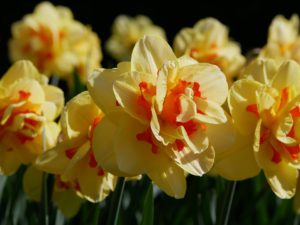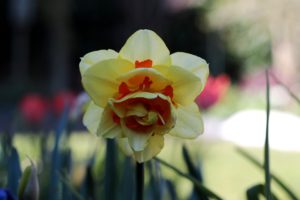How to Grow and Care for Daffodils

Daffodils are a hardy perennial plant that will not only brighten your garden but is a popular plant that will let you know that spring is here. These garden beauties can last for years with little care which I think is a great investment especially if you don’t have much time to work in your garden.
You can also brighten up your interior by growing and caring for daffodils on the inside, there are more than 50 species of these garden beauties giving you a whole range to choose from. For more on the growth and care of daffodils, let’s take a closer look.
Daffodil planting location
The planting location of daffodils should be full sunlight to partial shade but giving them full sunlight will cause daffodils to bloom their best. The bulbs should be planted 2-4 weeks before the ground freezes.
The soil type
The soil type should be moist and rich with a ph of slightly acidic to neutral.
Daffodil watering methods
During the spring and fall months give your daffodils regular watering, once the flowers fade discontinue watering for a month.
Fertilizing your daffodil
Daffodils will bloom even if you don’t fertilize but if the soil type you are growing your daffodils in is poor then applying bone meal or bulb plant food in the top few inches of soil will help greatly. This procedure should be done when the first leave appears and again when the daffodils flower.
Warning
Warning daffodils are toxic to pets so ensure that pets don’t venture in areas where daffodils are planted.
Garden insect pest of daffodil
Common pests problems include slugs, bulb mites, large narcissus bulb fly, and narcissus nematodes.
Narcissus bulb fly
large narcissus bulb fly is a serious problem causing the bulb to produce grass-like leaves but no flowers, some times the bulb will die. Creamy white maggots may be seen in the bulb along with muddy excrement. There is no known treatment except to place bulbs in hot water 110 f for about 3o minutes to eliminate maggots.
Bulb Mites
Bulb mites will cause the bulbs to discolor or turn reddish to brown and may rot before or after planting, control is difficult. If the bulb survives the flower stalk will not develop, leaves will be stunted, will also turn yellow and distorted. Preventive measures include storing bulbs in an environment with low humidity and cool temperature.
Slugs
A sure sign that slugs are making a meal out of your daffodils are holes in the leaves slugs can be controlled by applying slug bait throughout the planting area, handpicking and throwing them into a bucket of water, or try scattering dry eggshells around plants.
Narcissus Nematodes
Narcissus nematodes symptoms include foliage turning from yellow to brown along with distortion, infected plant seldom produce flowers, infected plants will develop poor roots, the leaf margin or flower stalk has yellow patches that are swollen and infected bulb may also die in storage.
Allow infected blubs to sit in hot water for 30 minutes may help, proper culture practice by adding organic matter may help by increasing microbial activity, ensure to purchase healthy bulbs from suppliers
Daffodil disease
Overwatering can lead to root so give daffodils the required amount of water if overwatering leads to root rot discontinue water and apply a fungicide according to the directions on the label.
Growing daffodil in containers
- When growing daffodils from containers choose a container that is 8 inches or larger
- Fill the container about a half or a litter more with good potting soil
- Place the bulbs in the container and give spacing. The daffodils point should be just below the rim of the container
- Then lightly cover the bulbs with more potting soil
- Moisten the soil with water
- Place the container in a cool dark location for about two to three and a half months with a temperature of 45 degrees or thereabout
- Only water when the soil is dry
- Once the cold has passed move the container to a sunny but cool area and continue to water as needed
- Move daffodils to indirect sunlight when leaves begin to emerge continue to water as needed
- Add bone meal or fertilizer

Caring for daffodil indoors
- When caring for daffodils indoors place near a window that gets indirect bright sunlight, direct sunlight will cause the foliage to burn along with causing the flower to fade.
- A room temperature of 5o-70 degrees will extend the bloom period
- The soil should be checked once or twice a week if the top first few inches of soil is dry water thoroughly
- Rotating the container daily or every few days will keep your daffodil from leaning to one side because it’s a known fact that indoor plants will grow towards which side is getting the greater amount of sunlight
- The use of a balanced liquid feed fertilizer at half strength will offer help
- Once the flower starts to bloom remove it from direct sunlight to prolong the bloom
- Remove the spent or faded flowers with scissors or hand pruner which will help your daffodil to reserve energy and collect nutrients
Using daffodils as cut flowers
If you are planning on using daffodils as cut flowers keep them by themself in a vase because there is a fluid that is created by the stem which will cause other flower cuttings to wilt. If you want to add them to a floral arrangement let daffodil cuttings soak in water for a while followed by thoroughly rinsing and then adding them to arrangements.
Deadheading daffodil
When the flowers begin to fade remove with a hand pruner, the removal of faded flowers will encourage bulbs to save their energy for the following year.
Daffodil names
Here are just a few daffodil names 12 in total
1. Miniature Daffodils.
2. Jonquilla Daffodils.
3. Triandurs Daffodils.
4. Jetfire Daffodils.
5. Cyclamineus Daffodils.
6. Tazetta Daffodils.
7. Poeticus Daffodils.
8. Quail Daffodils.
9. Sentinel Daffodils.
10. Trumpet or Long cup daffodils.
11. Spilt-Corona Daffodils.
12. Double Daffodils.
The final word on daffodil flowering plants
Growing and caring for daffodils is that simple these garden beauties have proven to brighten up both outdoor gardens as well as the interior. Following these simple steps will give you good results as you seek to take full advantage of these garden beauties. I believe that the time that’s invested in the care of daffodils is worth it so brighten your day by knowing how to grow and care for daffodils.
About the author
Norman loves being in the garden, both at home and for his job....
he is 'Natures Little helper' being outdoors, growing his vegetables and flowers from an early age.
Now having spent over 22 years in the profession he want to give some of his knowledge to others...
his vast array of hints and tips you will find scattered over this site will help you no end growing plants in your garden.
